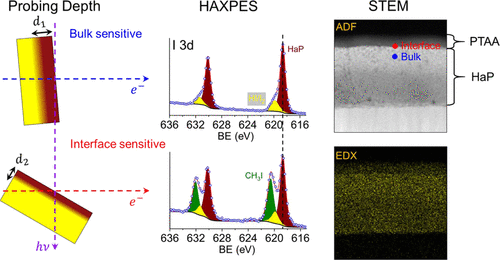当前位置:
X-MOL 学术
›
ACS Appl. Mater. Interfaces
›
论文详情
Our official English website, www.x-mol.net, welcomes your
feedback! (Note: you will need to create a separate account there.)
Chemical and Electronic Investigation of Buried NiO1−δ, PCBM, and PTAA/MAPbI3–xClx Interfaces Using Hard X-ray Photoelectron Spectroscopy and Transmission Electron Microscopy
ACS Applied Materials & Interfaces ( IF 8.3 ) Pub Date : 2021-10-13 , DOI: 10.1021/acsami.1c11215 Ibrahima Gueye 1, 2 , Yasuhiro Shirai 3 , Dhruba B Khadka 3 , Okkyun Seo 1, 2 , Satoshi Hiroi 1, 2 , Masatoshi Yanagida 3 , Kenjiro Miyano 3 , Osami Sakata 1, 2, 4, 5
ACS Applied Materials & Interfaces ( IF 8.3 ) Pub Date : 2021-10-13 , DOI: 10.1021/acsami.1c11215 Ibrahima Gueye 1, 2 , Yasuhiro Shirai 3 , Dhruba B Khadka 3 , Okkyun Seo 1, 2 , Satoshi Hiroi 1, 2 , Masatoshi Yanagida 3 , Kenjiro Miyano 3 , Osami Sakata 1, 2, 4, 5
Affiliation

|
Identification and profiling of molecular fragments generated over the lifespan of halide perovskite solar cells are needed to overcome the stability issues associated with these devices. Herein, we report the characterization of buried CH3NH3PbI3–xClx (HaP)–transport layer (TL) interfaces. By using hard X-ray photoelectron spectroscopy in conjunction with transmission electron microscopy, we reveal that the chemical decomposition of HaP is TL-dependent. With NiO1−δ, phenyl-C61-butyric acid methyl ester (PCBM), or poly(bis(4-phenyl) (2,4,6-trimethylphenyl)amine) (PTAA) as TLs, probing depth analysis shows that the degradation takes place at the interface (HaP/TL) rather than the HaP bulk area. From core-level data analysis, we identified iodine migration toward the PCBM– and PTAA–TLs. Unexpected diffusion of nitrogen inside NiO1−δ–TL was also found for the HaP/NiO1−δ sample. With a HaP/PCBM junction, HaP is dissociated to PbI2, whereas HaP/PTAA contact favored the formation of CH3I. The low stability of HaP solar cells in the PTAA–TL system is attributed to the formation of CH3I and iodide ion vacancies. Improved stability observed with NiO1−δ–TL is related to weak dissociation of stoichiometric HaP. Here, we provide a new insight to further distinguish different mechanisms of degradation to improve the long-term stability and performance of HaP solar cells.
中文翻译:

使用硬 X 射线光电子能谱和透射电子显微镜对埋藏的 NiO1-δ、PCBM 和 PTAA/MAPbI3-xClx 界面进行化学和电子研究
需要对卤化物钙钛矿太阳能电池在整个生命周期内产生的分子碎片进行鉴定和分析,以克服与这些设备相关的稳定性问题。在此,我们报告了掩埋 CH 3 NH 3 PbI 3- x Cl x (HaP)-传输层 (TL) 界面的表征。通过结合使用硬 X 射线光电子能谱和透射电子显微镜,我们揭示了 HaP 的化学分解是 TL 依赖性的。与 NiO 1-δ , 苯基-C 61-丁酸甲酯(PCBM)或聚(双(4-苯基)(2,4,6-三甲基苯基)胺)(PTAA)作为TLs,探测深度分析表明降解发生在界面(HaP/ TL) 而不是 HaP 大块区域。从核心级数据分析中,我们确定了碘向 PCBM 和 PTAA TL 的迁移。对于 HaP/NiO 1-δ样品,还发现了NiO 1-δ -TL内氮的意外扩散。通过 HaP/PCBM 结,HaP 与 PbI 2解离,而 HaP/PTAA 接触有利于 CH 3 I的形成。 PTAA-TL 系统中 HaP 太阳能电池的低稳定性归因于 CH 3 I 和碘离子空位。使用 NiO 1−δ观察到的稳定性提高–TL 与化学计量的 HaP 的弱解离有关。在这里,我们提供了一个新的见解,以进一步区分不同的降解机制,以提高 HaP 太阳能电池的长期稳定性和性能。
更新日期:2021-10-27
中文翻译:

使用硬 X 射线光电子能谱和透射电子显微镜对埋藏的 NiO1-δ、PCBM 和 PTAA/MAPbI3-xClx 界面进行化学和电子研究
需要对卤化物钙钛矿太阳能电池在整个生命周期内产生的分子碎片进行鉴定和分析,以克服与这些设备相关的稳定性问题。在此,我们报告了掩埋 CH 3 NH 3 PbI 3- x Cl x (HaP)-传输层 (TL) 界面的表征。通过结合使用硬 X 射线光电子能谱和透射电子显微镜,我们揭示了 HaP 的化学分解是 TL 依赖性的。与 NiO 1-δ , 苯基-C 61-丁酸甲酯(PCBM)或聚(双(4-苯基)(2,4,6-三甲基苯基)胺)(PTAA)作为TLs,探测深度分析表明降解发生在界面(HaP/ TL) 而不是 HaP 大块区域。从核心级数据分析中,我们确定了碘向 PCBM 和 PTAA TL 的迁移。对于 HaP/NiO 1-δ样品,还发现了NiO 1-δ -TL内氮的意外扩散。通过 HaP/PCBM 结,HaP 与 PbI 2解离,而 HaP/PTAA 接触有利于 CH 3 I的形成。 PTAA-TL 系统中 HaP 太阳能电池的低稳定性归因于 CH 3 I 和碘离子空位。使用 NiO 1−δ观察到的稳定性提高–TL 与化学计量的 HaP 的弱解离有关。在这里,我们提供了一个新的见解,以进一步区分不同的降解机制,以提高 HaP 太阳能电池的长期稳定性和性能。











































 京公网安备 11010802027423号
京公网安备 11010802027423号